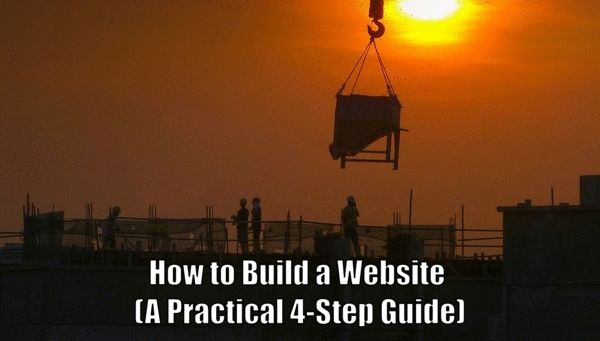How To Make A Website (A Practical 4-Step Guide)

Learning how to build a website is one of the most useful skills you can acquire. This is because modern sites can be used for anything from displaying your artistic talents, providing information about your business, and even creating an online store.
Despite this, many people choose to either hire a professional to build their website or completely ignore the usefulness of being able to create their own place in cyberspace. This might be due to the misconception that building a website is time and labor intensive, difficult, and requires multiple degrees in coding, design, and business.
Building a website today is as commonplace as it is simple. It's so easy, in fact, that we've managed to break it down into four parts that will have you running your own site (or sites) in no time!
1. Find a Host

The first step in your website building journey will be to find a web host. You can think of a host as the place where your website will live. Just like in real life where you have to pay rent to continue occupancy in your apartment, so too will you have to pay a monthly or annual rate to keep your website on a host's servers.
When choosing a host you will be asked how much server space you need. If you envision your website growing to epic proportions, you should opt for a great amount of space. If we're continuing the rent analogy, just as you pay more per square foot, so too will you pay more for additional online space.
There are many web hosting options and because of a high level of competition, most of them have excellent introductory offers. Upon signing up, you will be walked through the process of not only choosing your hosting package options but of purchasing a domain name.
Your domain name is your address on the internet and you should spend some time considering how you want to be known. If you already have a brand, you should use the brand name in your domain (ie 'yourbrandname.com'), but if you are creating an original site, keep in mind that your name should have some relation to what your site offers, should be short, and, most of all, catchy.
If you are looking for a list of our top website builders, look no further than our homepage!
2. Choose a Builder Platform
Every website is built on a platform. There are many to choose from, but they can be broken down into two general categories:
Website Builders
Website builders are all the rage these days -- and for good reason. They enable users to simply drag and drop elements onto pre-made templates that look both professional and modern. They also offer expandability through apps and add-ons.
Popular options like Wix take away all of the guesswork that comes with website creation through an intuitive and easy-to-use platform. They also serve as a host, making them an effective one-stop shop for everything you need to get your site online as soon as possible.
We always recommend website builders as the first choice for anyone looking to create their first site.
Content Management Systems
A content management system (CMS) is another way to manage digital content online, such as blogs and portfolios. WordPress, a well-known CMS, is the most popular website platform on the internet. This is because it is free, it enables users to create and manage amazing websites, and it is easy to learn.
WordPress requires installation on a host, which may sound daunting, but it has become so popular that most hosts, including eHost, offer one-click installation of the software. Once installed, you will be required to learn the platform using online guides and help forums.
CMSs are more difficult to master than website builders, and we usually recommend them only to those who are comfortable with a bit of trial and error. Once you master a CMS, you may find that it offers you many more possibilities.
Every website builder you will come across is built differently. Therefore, they all have their own unique pros and cons. Some are also easier to work with than others. Therefore, the more powerful and sophisticated the builder, the higher the website creation learning curve will be.
For instance, WordPress ranks among the most powerful of all free website builders and CMSs. It is also advanced, flexible, and can be programmed to do just about anything you want with a website.
However, to become proficient at using WP, you need to learn a lot. This means you have to dedicate a lot of time to know how it works exactly. Luckily, the returns on this time investment will be totally worth it. Once you are done learning, you will know how to create a great website in a matter of hours.
On the other hand, there are What You See Is What You Get (WYSIWYG) drag and drop builders. These ones are simpler to use because you don’t need to code to create a website with them. As such, they are great for people who don’t really have the time to start learning how to code or cannot afford to hire someone to help them create and build their website.
3. Design Your Website
One of the most fun parts of creating a website is adding a design that is uniquely you. All website platforms offer users hundreds to thousands of design options that range from generic enough to work on all sites to specific enough to fill any niche imaginable.
Just like designing a home, choosing a site theme is vital to conveying a message to your visitors. Whether you prefer simple and minimalist or loud and maximalist, you should always make sure that you maintain a good feng shui, enabling users to easily access the things they will need most and making things clear enough to find on all devices.
4. Market Like A Mad Man

Once you finish creating and designing your website you will want to garner traffic. Sure your friends and family might check it out, but you want to share your work beyond your social circles. Once you begin to gain traction, you will become addicted to growing even bigger. The more visitors you get, the more you will understand how much better you can do.
The first step to marketing your site is to create excellent content. Search engines like Google recognize great writing. You can take advantage of this by either cornering a new market segment or just doing something better than everyone else.
Once you have content down, you should create accounts on as many social media sites as possible. Twitter, Facebook, Tumblr, Google+, Instagram... The list is neverending, and neither should your endeavor to get your site out there be.
Once you get a good feel for who is searching for and reading your site you can even pay to advertise it, create guest posts on other sites, and become the integral part of the internet that you always want to be.
And that's it! Building a website isn't a difficult process and you may find that it's so fun and satisfying that you will want to create a whole network of sites. Like landing on the moon, all it takes is that first step.
